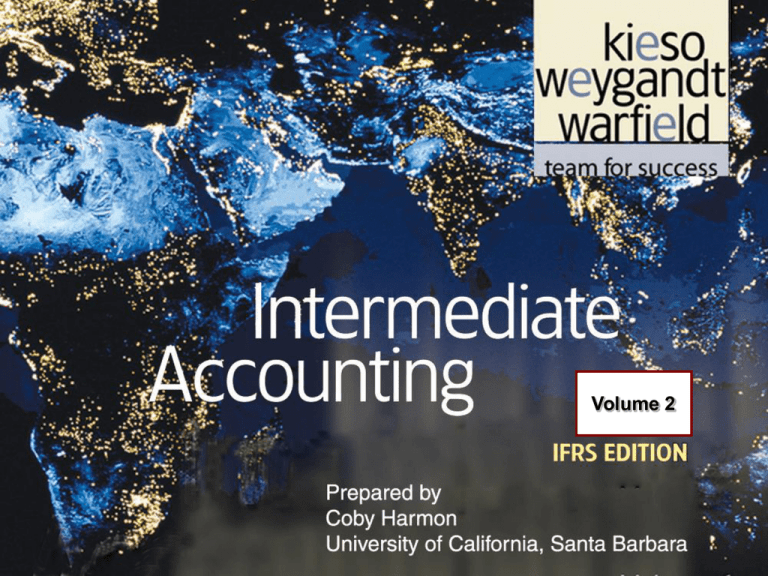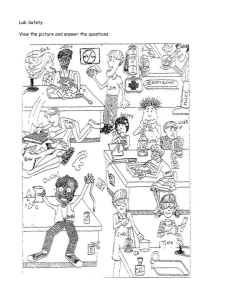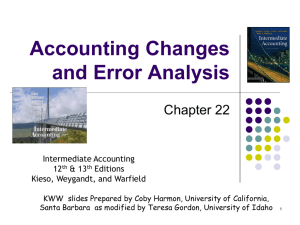
Volume 2
22-1
CHAPTER
22
ACCOUNTING CHANGES
AND ERROR ANALYSIS
Intermediate Accounting
IFRS Edition
Kieso, Weygandt, and Warfield
22-2
Learning Objectives
1.
Identify the two types of accounting changes.
2.
Describe the accounting for changes in accounting policies.
3.
Understand how to account for retrospective accounting changes.
4.
Understand how to account for impracticable changes.
5.
Describe the accounting for changes in estimates.
6.
Describe the accounting for correction of errors.
7.
Identify economic motives for changing accounting policies.
8.
Analyze the effect of errors.
22-3
Accounting Changes and Error Analysis
Accounting Changes
Changes in accounting
policy
Statement of financial
position errors
Changes in accounting
estimate
Income statement errors
Correction of errors
Summary
Motivations for change of
policy
22-4
Error Analysis
Statement of financial
position and income
statement effects
Comprehensive example
Preparation of statements
with error corrections
Accounting Changes
Tipe perubahan akuntansi :
1. Perubahan prinsip akuntansi (Change in Accounting Policy)
2. Perubahan estimasi akuntansi (Changes in Accounting
Estimate)
Errors are not considered an accounting change.
22-5
LO 1 Identify the two types of accounting changes.
Changes in Accounting Policy
Perubahan Prinsip Akuntansi : melibatkan perubahan
dari satu prinsip akuntansi yang berlaku umum ke yang
lainnya.
Contoh :
Average cost to LIFO.
Completed-contract to percentage-of-completion.
Adoption of a new policy in recognition of events that have occurred for
the first time or that were previously immaterial is not an accounting
change.
22-6
LO 2 Describe the accounting for changes in accounting policies.
Changes in Accounting Policy
Three approaches for reporting changes:
1) Pelaporan perubahan pada periode berjalan
2) Retrospectively : menyusun kembali laporan keuangan
tahun sebelumnya atas dasar yang konsisten dengan
prinsip yang baru diterapkan.
IASB requires use of the retrospective approach.
Rationale - Users can then better compare results from one period to
the next.
22-7
Changes in Accounting Policy
1) Prospectively (in the future) :
• Hasil yang dilaporkan sebelumnya biasanya tidak diubah.
• Saldo awal tidak perlu disesuaikan
FASB menyarankan agar perusahaan memakai pendekatan
retrospektif
22-8
Changes in Accounting Policy
Retrospective Accounting Change Approach
IFRS permits a change in policy if:
1) It is required by IFRS; or
2) It results in the financial statements providing more
reliable and relevant information.
22-9
LO 3 Understand how to account for retrospective accounting changes.
Changes in Accounting Policy
Retrospective Accounting Change: Long-Term Contracts
Illustration:
Denson Construction Co. teah memperhitungkan
labanya dari kontrak konstruksi jangka panjang dengan metode
kontrak selesai (Cost recovery method). Pada tahun 2011
perusahaan ini beralih ke metode persentase penyelesaian karena
manajemen percaya bahwa pendekatan ini akan menghasilkan
ukuran yang lebih tepat atas laba yang diperoleh.
Untuk keperluan pajak (asumsikan tarif pajak yang berlaku adalah
40%), perusahaan menerapkan metode cost recovery dan
merencanakan untuk terus menggunakan metode ini dimasa yang
akan datang.
22-10
Changes in Accounting Policy
Illustration 22-1
22-11
LO 3 Understand how to account for retrospective accounting changes.
Changes in Accounting Policy
Data for Retrospective Change
Illustration 22-2
Journal entry
beginning of
2010
22-12
Construction in Process
Deferred Tax Liability
Retained Earnings
220,000
88,000
132,000
LO 3 Understand how to account for retrospective accounting changes.
Changes in Accounting Policy
Reporting a Change in policy
Major disclosure requirements are as follows.
1.
Nature of the change in accounting policy;
2.
Reasons why applying the new accounting policy provides reliable
and more relevant information;
3.
For the current period and each prior period presented, to the
extent practicable, the amount of the adjustment:
4.
1.
For each financial statement line item affected; and
2.
Basic and diluted earnings per share.
Amount of the adjustment relating to periods before those
presented, to the extent practicable.
22-13
LO 3 Understand how to account for retrospective accounting changes.
Changes in Accounting Policy
Reporting a Change in policy
Illustration 22-3
22-14
LO 3
Changes in Accounting Policy
Retained Earnings Adjustment
Retained earnings balance is €1,360,000 at the beginning of 2009.
Illustration 22-4
Before Change
22-15
LO 3 Understand how to account for retrospective accounting changes.
Changes in Accounting Policy
Retained Earnings Adjustment
Illustration 22-5
22-16
After Change
LO 3 Understand how to account for retrospective accounting changes.
Changes in Accounting Policy
E22-1 (Change in policy—Long-Term Contracts): Cherokee
Construction Company changed from the cost-recovery to the
percentage-of-completion method of accounting for long-term
construction contracts during 2010. For tax purposes, the company
employs the cost-recovery method and will continue this approach
in the future. (Hint: Adjust all tax consequences through the
Deferred Tax Liability account.)
22-17
LO 3 Understand how to account for retrospective accounting changes.
Changes in Accounting Policy
E22-1 (Change in policy—Long-Term Contracts):
Instructions: (assume a tax rate of 35%)
(b) What entry(ies) are necessary to adjust the accounting records for
the change in accounting policy?
(a) What is the amount of net income and retained earnings that would
be reported in 2010? Assume beginning retained earnings for 2009 to
be $100,000.
22-18
LO 3 Understand how to account for retrospective accounting changes.
Changes in Accounting Policy
E22-1: Pre-Tax Income from Long-Term Contracts
Date
Percentageof-Completion
2009
$
2010
CostRecovery
Difference
35%
Tax
Effect
Net of
Tax
780,000
$ 610,000
170,000
59,500
$ 110,500
700,000
480,000
220,000
77,000
143,000
Journal entry
2010
Construction in progress
Deferred tax liability
Retained earnings
22-19
170,000
59,500
110,500
LO 3 Understand how to account for retrospective accounting changes.
Changes in Accounting Policy
E22-1: Comparative Statements
Restated
2009
2010
Income
Statement
Statement
of Retained
Earnings
Pre-tax income
Income tax (35%)
700,000
$
245,000
780,000
$ 610,000
273,000
213,500
Net income
$
455,000
$
507,000
$ 396,500
Beg. Retained earnings
$
496,500
$
100,000
$ 100,000
607,000
100,000
100,000
455,000
507,000
396,500
607,000
$ 496,500
Accounting change
Beg. R/Es restated
Net income
End. Retained earnings
22-20
$
Previous
2009
110,500
$
$ 1,062,000
$
LO 3 Understand how to account for retrospective accounting changes.
Changes in Accounting Policy
Impracticability
Perusahaan tidak boleh memakai penerapan retrospektif bila
menemui salah satu kondisi berikut ini :
1. Perusahaan tidak dapat menentukan pengaruh penerapan
retrospektif
2. Penerapan retrospektif memerlukan penetapan asumsiasumsi mengenai rencana kerja pihak manajemen pada
periode terdahulu
3. Penerapan retrospektif memerlukan estimasi-estimasi
signifikan terkait periode terdahulu, dan tidak disahkan
secara objektif.
22-21
LO 4 Understand how to account for impracticable changes.
Changes in Accounting Estimate
Examples of Estimates
1. Piutang tak tertagih
2. Keusangan persediaan
3. Umur manfaat dan nilai sisa aktiva
4. Periode yang menerima manfaat dari biaya yang
ditangguhkan
5. Kewajiban untuk biaya garansi dan pajak penghasilan
6. Change in depreciation methods.
7. Fair value of financial assets or financial liabilities.
22-22
LO 5 Describe the accounting for changes in estimates.
Changes in Accounting Estimate
Prospective Reporting
Changes in accounting estimates are reported prospectively.
Account for changes in estimates in
1. the period of change if the change affects that period only,
or
2. the period of change and future periods if the change
affects both.
IASB views changes in estimates as normal recurring corrections
and adjustments and prohibits retrospective treatment.
22-23
LO 5 Describe the accounting for changes in estimates.
Change in Estimate Example
Illustration: Arcadia High School purchased equipment for
$510,000 which was estimated to have a useful life of 10 years
with a salvage value of $10,000 at the end of that time.
Depreciation has been recorded for 7 years on a straight-line
basis. In 2010 (year 8), it is determined that the total estimated life
should be 15 years with a salvage value of $5,000 at the end of
that time.
Required:
22-24
What is the journal entry to correct
prior years’ depreciation expense?
Calculate depreciation expense for 2010.
No Entry
Required
LO 5 Describe the accounting for changes in estimates.
Change in Estimate Example
Equipment cost
Salvage value
Depreciable base
Useful life (original)
Annual depreciation
After 7 years
$510,000
First, establish NBV
- 10,000
at date of change in
500,000
estimate.
10 years
$ 50,000 x 7 years = $350,000
Balance Sheet (Dec. 31, 2009)
Fixed Assets:
22-25
Equipment
Accumulated depreciation
$510,000
350,000
Net book value (NBV)
$160,000
LO 5 Describe the accounting for changes in estimates.
Change in Estimate Example
Net book value
Salvage value (if any)
Depreciable base
Useful life
Annual depreciation
$160,000
5,000
155,000
8 years
$ 19,375
Second, calculate
depreciation expense
for 2010.
Journal entry for 2010
Depreciation expense
Accumulated depreciation
22-26
19,375
19,375
LO 5 Describe the accounting for changes in estimates.
Changes in Accounting Estimate
Disclosures
Companies should disclose the nature and amount of a
change in an accounting estimate that has an effect in the
current period or is expected to have an effect in future periods.
Companies need not disclose changes in accounting estimate
made as part of normal operations, such as bad debt allowances
or inventory obsolescence, unless such changes are material.
22-27
LO 5 Describe the accounting for changes in estimates.
Correction of Errors
Types of Accounting Errors:
1. A change from an accounting policy that is not generally
accepted to an accounting policy that is acceptable. (dari
non PABU menjadi PABU)
2. Mathematical mistakes.
3. Changes in estimates that occur because a company did
not prepare the estimates in good faith.
4. Failure to accrue or defer certain expenses or revenues.
5. Misuse of facts (contoh : nilai sisa tidak dimasukkan ke
dalam dasar penyusutan untuk metode garis lurus)
6. Incorrect classification of a cost as an expense instead of
an asset, and vice versa.
22-28
Correction of Errors
Illustration: In 2012 the bookkeeper for Selectro Company
discovered an error:
Pada tahun 2011 perusahaan lalai mencatat dalam akun beban
penyusutan sebesar $20,000 atas gedung yang baru dibangun.
Penyusutan ini telah secara tepat dimaukkan dalam SPT pajak.
Ilustrasi menyajikan laporan laba rugi Selectro tahun 2011.
22-29
LO 6 Describe the accounting for correction of errors.
Correction of Errors
Illustration: Selectro’s income statement for 2011 with and without
the error.
Illustration 22-17
Show the entries that Selectro should have made and did make for
recording depreciation expense and income taxes.
22-30
LO 6 Describe the accounting for correction of errors.
Correction of Errors
Sebagai akibat dari kesalahan tidak memasukkan beban sebesar
$20,000 di tahun 2011 :
Pengaruh terhadap Laporan Laba Rugi:
Beban penyusutan (2011) telah dinyatakan terlalu rendah $20,000
Beban pajak penghasilan (2011) telah dinyatakan terlalu tinggi
sebesar $8,000 ($20,000 x 40%)
Laba bersih tahun 2011 telah dinyatakan terlalu tinggi sebesar
$12,000 (20,000-8000)
Pengaruh terhadap Neraca:
Akumulasi penyusutan-bangunan telah dinyatakan terlalu rendah
sebesar $20,000
Kewajiban pajak yang ditangguhkan telah dinyatakan terlalu tinggi
sebesar $80,000 (20,000 x 40%)
22-31
Correction of Errors
Illustration: Show the entries that Selectro should have made and
did make for recording depreciation expense and income taxes.
Illustration 22-18
Correcting
Entry in
2012
22-32
LO 6 Describe the accounting for correction of errors.
Correction of Errors
Illustration: Show the entries that Selectro should have made and
did make for recording depreciation expense and income taxes.
Illustration 22-18
Correcting
Entry in
2012
22-33
Retained Earnings
12,000
LO 6 Describe the accounting for correction of errors.
Correction of Errors
Illustration: Show the entries that Selectro should have made and
did make for recording depreciation expense and income taxes.
Illustration 22-18
Correcting
Entry in
2012
22-34
Retained Earnings
Deferred Tax Liability
12,000
Reversal
8,000
LO 6 Describe the accounting for correction of errors.
Correction of Errors
Illustration: Show the entries that Selectro should have made and
did make for recording depreciation expense and income taxes.
Illustration 22-18
Correcting
Entry in
2012
22-35
Retained Earnings
Deferred Tax Liability
12,000
8,000
Accumulated Depreciation—Buildings
Record
20,000
Summary of Accounting Changes and Errors
Illustration 22-23
22-36
LO 6
Copyright
Copyright © 2011 John Wiley & Sons, Inc. All rights reserved.
Reproduction or translation of this work beyond that permitted in
Section 117 of the 1976 United States Copyright Act without the
express written permission of the copyright owner is unlawful.
Request for further information should be addressed to the
Permissions Department, John Wiley & Sons, Inc. The purchaser
may make back-up copies for his/her own use only and not for
distribution or resale. The Publisher assumes no responsibility for
errors, omissions, or damages, caused by the use of these
programs or from the use of the information contained herein.
22-37





